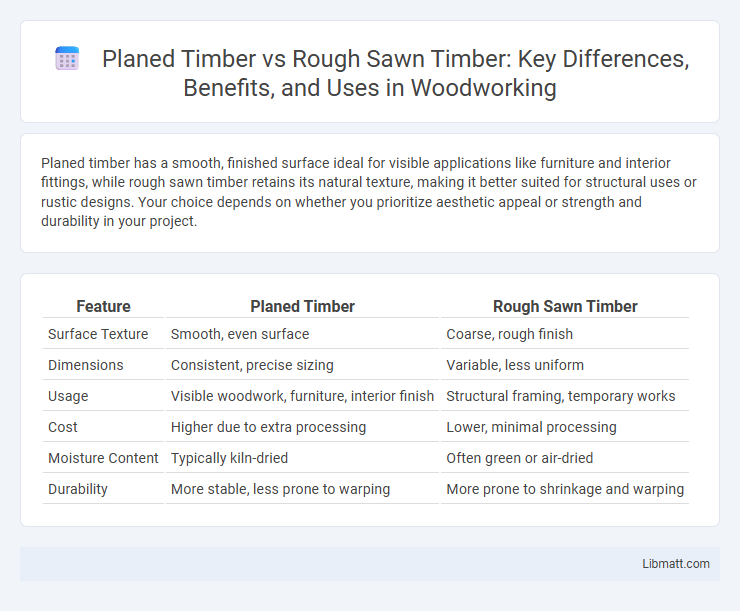Planed timber has a smooth, finished surface ideal for visible applications like furniture and interior fittings, while rough sawn timber retains its natural texture, making it better suited for structural uses or rustic designs. Your choice depends on whether you prioritize aesthetic appeal or strength and durability in your project.
Table of Comparison
| Feature | Planed Timber | Rough Sawn Timber |
|---|---|---|
| Surface Texture | Smooth, even surface | Coarse, rough finish |
| Dimensions | Consistent, precise sizing | Variable, less uniform |
| Usage | Visible woodwork, furniture, interior finish | Structural framing, temporary works |
| Cost | Higher due to extra processing | Lower, minimal processing |
| Moisture Content | Typically kiln-dried | Often green or air-dried |
| Durability | More stable, less prone to warping | More prone to shrinkage and warping |
Introduction to Planed and Rough Sawn Timber
Planed timber is smooth and finished, making it ideal for visible applications like furniture and interior joinery due to its consistent dimensions and refined surface. Rough sawn timber retains the natural texture from the sawmill, providing a rustic look favored for outdoor structures and projects where texture and grip are important. Your choice between planed and rough sawn timber depends on the desired aesthetic, finish requirements, and specific construction needs.
What is Planed Timber?
Planed timber is wood that has been smoothed and flattened using a planing machine, resulting in uniform thickness and a polished surface suitable for visible applications. This process removes rough edges and irregularities found in rough sawn timber, enhancing the wood's aesthetic appeal and making it easier to handle and finish. Your choice of planed timber ensures a professional look and consistent dimensions for furniture, flooring, or interior paneling projects.
What is Rough Sawn Timber?
Rough sawn timber is wood that has been cut from the log but left with a coarse, textured surface, retaining its natural saw marks and uneven edges. Unlike planed timber, it has not been smoothed or finished, offering a rustic appearance and greater thickness. Your choice between rough sawn and planed timber depends on whether you need raw, robust material for structural use or a refined finish for aesthetic projects.
Key Differences Between Planed and Rough Sawn Timber
Planed timber features a smooth, even surface due to machinery that removes the rough outer layer, improving its appearance and making it easier to handle for precise woodworking projects. Rough sawn timber retains its natural, coarse texture because it is cut directly from logs without further finishing, offering greater strength and a rustic aesthetic suited for structural uses or decorative applications. Your choice depends on whether you prioritize smoothness and finish quality or natural texture and durability for your project.
Advantages of Planed Timber
Planed timber offers a smooth, clean finish that reduces the need for sanding and makes it ready for immediate use in construction or furniture projects. Its uniform thickness and dimensions enhance precision during assembly, ensuring a better fit and stronger structural integrity. When you choose planed timber, you benefit from ease of handling, improved appearance, and time savings on surface preparation.
Benefits of Using Rough Sawn Timber
Rough sawn timber offers superior strength and durability compared to planed timber due to its thicker, less processed surface, making it ideal for structural applications. Its natural, textured finish enhances grip and reduces the risk of slipping in outdoor decking and landscaping projects. Using rough sawn timber also provides cost savings since it requires less manufacturing time and energy, supporting eco-friendly building practices.
Ideal Applications for Planed Timber
Planed timber is ideal for interior applications such as furniture making, cabinetry, and decorative trim due to its smooth surface and precise dimensions. It provides a refined finish that enhances aesthetics and simplifies painting or staining processes. Its uniformity reduces the need for additional sanding, making it perfect for projects requiring high-quality, polished wood.
Best Uses for Rough Sawn Timber
Rough sawn timber, characterized by its textured surface and natural edges, is ideal for rustic furniture, fencing, and outdoor landscaping projects where an authentic, rugged appearance is desired. Its superior thickness and durability make it suitable for structural uses such as beams, posts, and framing in barns or sheds. Rough sawn timber also excels in applications requiring enhanced grip and traction, like decking in non-slip environments.
Price Comparison: Planed vs Rough Sawn Timber
Planed timber generally commands a higher price than rough sawn timber due to its smoother finish and readiness for immediate use, which reduces labor costs in construction or woodworking projects. Rough sawn timber is less expensive because it requires additional processing such as sanding and planing to achieve a finished surface, appealing to budget-conscious buyers willing to invest time in finishing. Market prices vary based on wood species and grade, with planed timber offering better value for projects requiring precision and aesthetics.
Choosing the Right Timber for Your Project
Planed timber offers a smooth, finished surface ideal for visible applications such as furniture and interior joinery, ensuring ease of painting or staining. Rough sawn timber retains a rustic texture and is typically more affordable, making it suitable for structural framing or outdoor projects where appearance is less critical. Selecting between planed and rough sawn timber depends on the project's aesthetic requirements, budget, and the need for additional surface preparation.
Planed timber vs rough sawn timber Infographic

 libmatt.com
libmatt.com